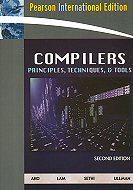Compilers: Principles, Techniques & Tools
2nd Edition
|
|
Aho, Lam, Sethi, Ullman
|

|

From the Preface
In the time since the 1986 edition of this book, the world of compiler design has changed significantly […]
Thus, our philosophy from pervious versions of the book has not changed. […] We …. emphasize problems that are most commonly encountered in designing a language processor, regardless of the source language or target machine…
Chapter 1 contains motivational material and also presents some background issue in computer architecture and programming-language principles.
Chapter 2 develops a miniature compiler and introduces many of the important concepts, which are then developed in later chapters [...]
Chapter 3 covers lexical analysis, regular expressions, finite-state machines, and scanner-generator tools.[…]
Chapter 4 covers the major parsing methods, top-down and bottom-up.[…]
Chapter 5 introduces the principal ideas in syntax-directed definitions and syntax-directed translations.
Chapter 6 takes the theory of Chapter 5 and shows how to use it to generate intermediate code for a typical programming language.
Chapter 7 covers run-time environments.[…]
Chapter 8 is on object-code generation.[…]
Chapter 9 introduces the technology of code optimization, including flow-graphs, data-flow frameworks and iterative algorithms for solving these frameworks.[…]
Chapter 10 covers instruction-level optimization.[…]
Chapter 11 talks about large-scale parallelism detection and exploitation.[…]
Chapter 12 is on interprocedural analysis.[…]
|
|
